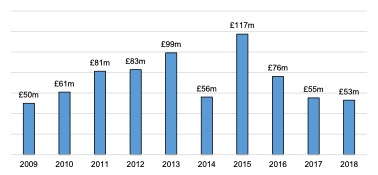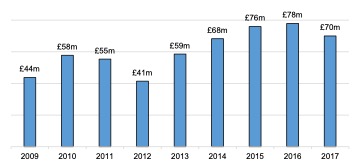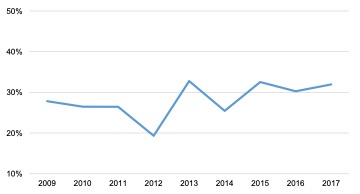Marine Sector Overview
England
This section presents an economic overview (where data allows) of the marine sector in the English Solway Firth with changes over the last five years across economic indicators presented in the table below. This is based on the core marine sectors of shipping and transport and sea fisheries, and the ancillary marine sectors of fish processing, defence, energy and sport recreation and tourism. (Please see the Sport, Recreation, and Tourism section for a definition of Sport, Recreation, and Tourism and caveats within the data.)
| Economic Contribution of the English Solway Firth, 2014 – 2018 |
|
Employment |
Turnover |
GVA |
|
Total |
% Change |
Total |
% Change |
Total |
% Change |
| Core Marine Sector Activity |
| Sea Fisheries |
35 |
+133% |
£3.4m |
-34% |
£1.5m |
-33% |
| Shipping and Transport |
40 |
-47% |
n/a |
n/a |
n/a |
n/a |
| Total Economic Contribution |
75 |
-17% |
£3.4m |
-34% |
£1.5m |
-33% |
| Ancillary Marine Activity |
| Fish Processing |
100 |
-33% |
n/a |
n/a |
n/a |
n/a |
| Defence |
175 |
-22% |
n/a |
n/a |
n/a |
n/a |
| Energy |
80 |
+14% |
n/a |
n/a |
n/a |
n/a |
| Sport, Recreation, and Tourism |
4,245 |
+2% |
£148m |
-23% |
£53m |
-5% |
| Total Economic Contribution |
4,600 |
0% |
£148m |
-23% |
£53m |
-5% |
Source: Office for National Statistics (Various) (BRES) and Office for National Statistics (Various) (ABS)
Note:
GVA and turnover have been uprated to 2018 prices using the GDP Deflator
Across the core marine sectors, there has been an overall decline in employment across the English Solway over the last five years, this has been driven by a decline in Shipping and Transport employment, see figure below, ‘English Solway – Core Marine Sector Employment, 2009-2018’.

English Solway- Core Marine Sector Employment, 2009 – 2018. (Source: Office for National Statistics (Various) (BRES) and Office for National Statistics (Various) (ABS))
Employment in the ancillary sector is dominated by the Sport, Recreation, and Tourism sector where employment has been on a slight downward trend, see figure below, ‘English Solway – Ancillary Marine Sector Employment 2009 – 2018’.

English Solway- Ancillary Marine Sector Employment, 2009 – 2018. (Source: Office for National Statistics (Various) (BRES) and Office for National Statistics (Various) (ABS))
Total turnover from core marine sector activities has broadly remained stable, with some fluctuations with peaks of just over £5m in 2010 and 2014, see figure below, ‘English Solway – Core Marine Sector Turnover, 2009 – 2018’. The available data for core marine sector activities is from Sea Fisheries – this is discussed in more detail in the Sea Fisheries section.

English Solway- Core Marine Sector Turnover, 2009 – 2018. (Source: Office for National Statistics (Various) (Bespoke). Adjusted to 2018 prices)
Total turnover from ancillary sector marine activities has been prone to fluctuation, peaking in 2014 and has declined since that time. However, this is entirely down to one sector, which dominates the data: Tourism, Sport and Recreation, see figure below, ‘English Solway – Ancillary Marine Sector Turnover, 2009 – 2018’.

English Solway- Ancillary Marine Sector Turnover, 2009 – 2017. (Source: Office for National Statistics (Various) (Bespoke). Adjusted to 2018 prices)
Annual GVA output from core marine activities was broadly stable over time, albeit with annual variations, with notable spikes in 2010 and 2014, see figure below, ‘English Solway: Core Marine Sector GVA, 2009 – 2018’.

English Solway: Core Marine Sector GVA, 2009 – 2018. (Source: Office for National Statistics (Various) (Bespoke). Adjusted to 2018 prices)
GVA for the ancillary marine sector increased each year to 2013, peaked in 2015, and has experienced a decline in each year since, see figure below, ‘English Solway – Ancillary Marine Sector GVA, 2009 – 2018’.

English Solway- Ancillary Marine Sector GVA, 2009 – 2018. (Source: Office for National Statistics (Various) (Bespoke). Adjusted to 2018 prices)
The relationship between turnover and GVA provides a measure of productivity with a high ratio indicating greater productivity. The data indicates that productivity in the core marine sector has been broadly steady, see figure below, ‘English Solway – Core Marine Sector GVA to Turnover Ratio, 2009 – 2018′.

English Solway – Core Marine Sector GVA to Turnover Ratio, 2009 – 2018. (Source: Office for National Statistics (Various) (Bespoke). Adjusted to 2018 prices)
Across the ancillary sectors, the ratio has fluctuated – albeit from a fairly low base, indicating the typically lower value of jobs in the tourism sector, see figure below, ‘English Solway – Ancillary Marine Sector GVA to Turnover Ratio, 2009 – 2018’.

English Solway – Ancillary Marine Sector GVA to Turnover Ratio, 2009 – 2018. (Source: Office for National Statistics (Various) (Bespoke). Adjusted to 2018 prices)


















